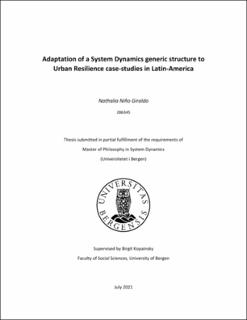| dc.description.abstract | Historically, the System Dynamics field has been using generic structures to transfer general knowledge from one dynamic situation to another. Although generic structures are widely used, there are still opportunities to explore how to use them in specific situations. This research project aims to determine the applicability of a generic resilience structure to different resilience assessment cases/contexts and based on that derive a framework for using generic structures. To achieve that, a resilience generic structure was adapted to five case studies in different Latin-American cities with the same purpose, to analyze the city’s ability to withstand disturbances. The original structure, proposed by Zhao et al. (2019), is a canonical situation model designed for assessing resilience of social-ecological systems (SES) with two stocks connected through density-dependence mechanisms. The use of the generic structure through the cases has shown that updates for the model include the extension of disturbance’s definition and the re-scale of the model to relative terms when lack of data and short time frame are limitations in the modelling process. The framework for adapting generic structures to case studies follows the same modelling steps described by Sterman (2000) with a sub-step called Type of situation in which the modeller can reason about how appropriate is the generic structure for the type of situation of the case study. An important insight related to validation is that a generic structure must fulfill at least the tests used for case-specific models plus being validated through the case studies in order to show its generality. The results made evident that using generic structures is practical and saves time in the modelling process since it does not require building a structure from scratch; however, there is a trade-off with the model’s level of aggregation. Also, when using canonical situation models, it is important to identify the nature of the case study problem from the beginning, so the modeller can identify if the generic structure works or if a more specific/detailed structure is needed. Finally, the exercise made in this research project demonstrated that generic structures make the learning process of the feedback and behavioral mechanisms behind complex systems faster and more intuitive over time. | |
